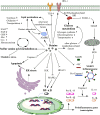Betaine in Inflammation: Mechanistic Aspects and Applications
- PMID: 29881379
- PMCID: PMC5976740
- DOI: 10.3389/fimmu.2018.01070
Betaine in Inflammation: Mechanistic Aspects and Applications
Abstract
Betaine is known as trimethylglycine and is widely distributed in animals, plants, and microorganisms. Betaine is known to function physiologically as an important osmoprotectant and methyl group donor. Accumulating evidence has shown that betaine has anti-inflammatory functions in numerous diseases. Mechanistically, betaine ameliorates sulfur amino acid metabolism against oxidative stress, inhibits nuclear factor-κB activity and NLRP3 inflammasome activation, regulates energy metabolism, and mitigates endoplasmic reticulum stress and apoptosis. Consequently, betaine has beneficial actions in several human diseases, such as obesity, diabetes, cancer, and Alzheimer's disease.
Keywords: betaine; endoplasmic reticulum; inflammation; obesity; oxidative stress.
Figures


References
-
- Yu D, Xu Z. Effects of betaine on growth performance and carcass characteristics in growing pigs. Asian-australas J Anim Sci (2004) 17(12):490–3.10.5713/ajas.2004.1700 - DOI
Publication types
MeSH terms
Substances
LinkOut - more resources
Full Text Sources
Other Literature Sources

